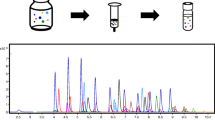Abstract
A simple GC-MS method has been developed and validated for the direct determination of hexamethylenetetramine (HMT). The separation of HMT was performed using a MXT-1 column. The calibration curve was linear over the concentration range 0.1-25 μg/mL, with a good correlation coefficient (r =0.9996). The recoveries of HMT from foods spiked at 1, 5, and 10 μg/g ranged from 91.7% to 115.2%. Intra-day (n=5) and inter-day (n=5) precision were less than 7%. The limit of detection and the limit of quantification of the method were 0.05 and 0.15 μg/mL, respectively. The uncertainties associated with food matrix and calibration contributed most to the overall expanded uncertainty. The method validation data indicated that quantitative method could be applied to the direct determination of non-hydrolyzed HMT in foods.
Similar content being viewed by others
References
Restani P, Corsini E, Galli CL. A novel approach to quantify the amount of formaldehyde added to milk in grana padano cheese production. J. Food Sci. 54: 578–580 (1989)
European Commission. European Parliament and Council Directive No 95/2/EC on Food Additives other than Colors and Sweeteners. Off. J. Eur. Comm. L61: 1–40 (1995)
Codex Alimentarius Commission. CODEX General Standard for Food Additives CODEX STAN 192-1995. Available from: http://www.codexalimentarius.net/gsfaonline/docs/CXS192e.pdf. Accessed Mar. 3, 2015.
Korea Ministry of Food and Drug Safety. Korea Food Additives Code. Korea Food Industry Association, Seoul, Korea (2014)
US Food and Drug Administration (FDA). Food Additive Listings. Available from: http://www.fda.gov/Food/IngredientsPackagingLabeling/FoodAdditives Ingredients. Accessed Mar. 3, 2015.
Ministry of Health, Labor and Welfare. Food Additives. Available from: http://www.mhlw.go.jp/english/topics/foodsafety/foodadditives. Accessed Mar. 3, 2015.
Joint FAO/WHO Expert Committee on Food Additives. Toxicological evaluation of certain food additives with a review of general principles and of specifications. WHO Technical Report Series No. 539. Available from: http://apps.who.int/food-additives-contaminants-jecfa-database/search.aspx. Accessed Mar. 3, 2015.
World Health Organization (WHO). Formaldehyde. Environmental Health Criteria 89 (Geneva: WHO) (1989)
Lim HS, Kim JI, Ko KY, Kim M. Determination of hexamethylenetetramine in foods by high-performance liquid chromatography (HPLC). Food Addit. Contam. A 31: 1489–1495 (2014)
Pavitrapok C, Williams DA. Determination of methenamine, methenamine mandelate and methenamine hippurate in pharmaceutical preparations using ion-exchange HPLC. J. Pharm. Biomed. Anal. 40: 1243–1248 (2006)
Koga M, Shinohara R, Akiyama T. Gas chromatographic determination of trace amounts of hexamethylenetetramine in water using an iodine charge-transfer complex. Anal. Sci. 1: 381–384 (1985)
Cottin H, Szopa C, Moore MH. Production of hexamethylenetetramine in photolyzed and irradiated interstellar cometary ice analogs. Astrophys. J. 561: 139–142 (2001)
Association of Official Analytical Chemists. Guidelines for single laboratory validation of chemical methods for dietary supplements and botanicals. Available from: http://www.aoac.org/imis15_prod/AOAC_Docs/Standards Development/SLV_guidelines_DietarySupplements.pdf>Accessed Mar. 3, 2015.
International Conference on Harmonization (ICH). ICH harmonised tripartite guideline, validation of analytical procedures: text and methodology Q2 (R1). Available from: http://www.ich.org. Accessed Mar. 3, 2015.
International Organization for Standardization. Guide to the expression of uncertainty in measurement (GUM). Available from: http://www.bipm.org/utils/common/documents/jcgm/JCGM_100_2008_E.pdf. Accessed Mar. 3, 2015.
EURACHEM/CITAC Guide. CG4: Quantifying Uncertainty in Analytical Measurement. Available from: http://eurachem2011.fc.ul.pt/pdf/QUAM 2012_DIS1.pdf. Accessed Mar. 3, 2015.
Stein SE. An integrated method for spectrum extraction and compound identification from gas chromatography/mass spectrometry data. J. Am. Soc. Mass Spectr. 10: 770–781 (1999)
McMaster MC. GC/MS: A practical user’s guide. 2nd ed. John Wiley & Son, Inc., Hoboken, NJ, USA. pp. 1-180 (2008)
Strom JG, Jun HW. Separation and quantitation of methenamine in urine by ion-pair extraction. J. Pharm. Sci. 75: 416–420 (1986)
Iwakami Y, Takzono M. Thermal decomposition of hexamethylene tetramine. B. Chem. Soc. Jpn. 41: 813–817 (1968)
Author information
Authors and Affiliations
Corresponding author
Rights and permissions
About this article
Cite this article
Lim, H.S., Hwang, J.Y., Kim, J.I. et al. Validation and measurement uncertainty evaluation of the GC-MS method for the direct determination of hexamethylenetetramine from foods. Food Sci Biotechnol 25, 1305–1311 (2016). https://doi.org/10.1007/s10068-016-0205-5
Received:
Revised:
Accepted:
Published:
Issue Date:
DOI: https://doi.org/10.1007/s10068-016-0205-5




